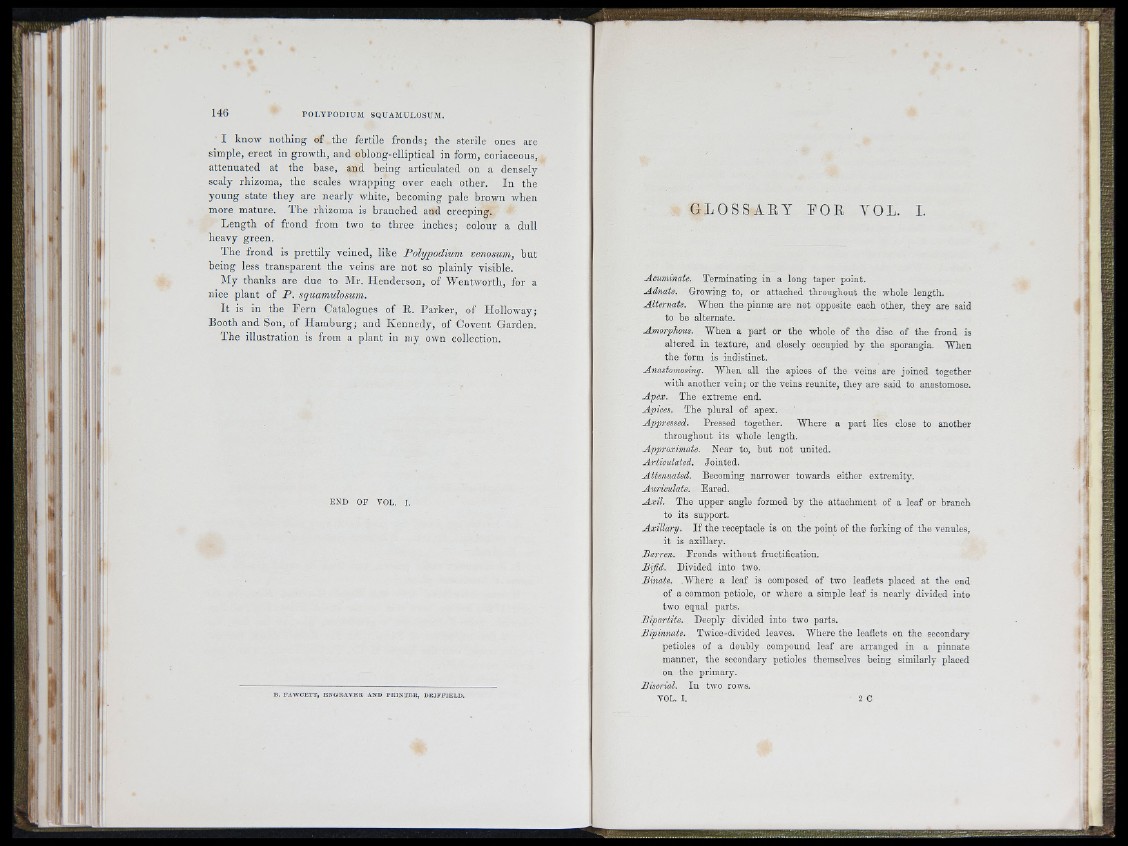
■J'
’ I
I IÎ Lm A-'i
I:: Ii I 5
• J !'!
'■
A ll;i
il!
I know nothing of the fertile fronds; the sterile ones are
simple, erect in growth, and oblong-elliptical in form, coriaceous,
attenuated at the base, and being articulated on a densely
scaly rhizoma, the scales wrapping over each other. In the
young state they are nearly white, becoming pale brown w'hen
more mature. The rhizoma is branched and creeping.
L en g th of frond from two to three inches; colour a dull
heavy green.
T h e frond is p re ttily veined, like P olypodium venosum, but
being less tran sp a ren t the veins are not so plainly visible.
Aly thanks are due to Air. Henderson, of AVentworth, for a
nice plant of P . squamulosum.
I t is in the T e rn Catalogues of R. P a rk e r, of Hollow'ay;
Booth and Son, of H am b u rg ; and Kenn ed y , of Covent Garden.
T he illustration is from a plant in my own collection.
END OF VOL. I.
B , FAW C E T T , EN G R A V E R AND F R IN T E R , D R IF F IE L D .
GLOSSAEY FOE VOL. I.
Acuminate. Terminating iu a long taper point,
Adnate. Growing to, or attached throughout the whole length.
Alternate. AVhen the pinnæ are not opposite each other, they are said
to be alternate.
Amorphous. AVhen a part or the whole of the disc of the frond is
altered in texture, and closely occupied by the sporangia, AVhen
the form is indistinct.
Anastomosing. AVhen all the apices of the veins are joined together
with another vein; or the veins reunite, they are said to anastomose.
Apex. The extreme end.
The plural of apex.
Pressed together. AVhere a part lies close to another
throughout its whole length.
Approximate. Near to, but not united.
Articulated. Jointed.
Attenuated. Becoming narrower towards either extremitj'.
Auriculate. Eared.
Axil. The upper angle formed by the attachment of a leaf or branch
to its support.
Axillary. I f the receptacle is on the point of the forking of the venules,
it is axillary.
Barren. Fronds without fructification.
Bifid. Divided into two.
Binate. AVhere a leaf is composed of two leaflets placed at the end
of a common petiole, or where a simple leaf is nearly divided into
two equal parts.
Bipartite. Deeply divided into two parts.
Bipinnate. Twice-divided leaves. AVhere the leaflets on the secondary
petioles of a doubly compound leaf are arranged in a pinnate
manner, the secondary petioles themselves being similarly placed
on the primary.
Biserial. In two rows.
VOL. 1. 2 C